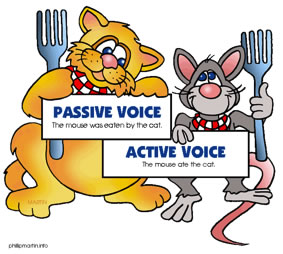Editing for Proper Voice

Source: Active vs. Passive Voice, Phillip Martin
You have been told to write in your own voice, which means writing so that the words and sentences sound like they are from a real person: you. There is another meaning of voice as it applies to writing, however, and this one has to do with verbs. The voice of a verb tells whether the subject performs or receives the action. In English there are two voices, active and passive.
In active voice, the subject of the sentence does the action of the verb, as shown in these examples:
- Before the prom, Grace’s group of friends ate dinner. (group ate)
- Mom loves Dad. (Mom loves)
- Shakespeare wrote 37 plays. (Shakespeare wrote)
Because active voice is direct, lively, to the point, and more natural, writing handbooks and teachers urge you to use it as much as possible in your writing.
In passive voice, the subject of the sentence receives the action of the verb. A form of to be is combined with the past participle of a main verb to form the passive voice. Here are the previous sentences expressed in passive voice:
- Before the prom, dinner was eaten by Grace’s group of friends. (dinner was eaten)
- Dad is loved by Mom. (Dad is loved)
- Thirty-seven plays were written by Shakespeare. (plays were written)
Passive voice sentences tend to be longer and awkward in a beating-around-the-bush kind of way, and some people consider them to be boring, stuffy, or hard to understand. In most cases, passive voice saps the strength from sentences.
Although passive voice is generally frowned upon, it is not altogether wrong, and some situations even call for its use. Passive voice is preferable if you want to
- call attention to the receiver of the action rather than the performer, in which case
the receiver should be the subject of the sentence.
—The quarterback was penalized five times.
- avoid saying who is taking the action. (This is often used in politics and business.)
—Mistakes were made.
—Your electricity will be turned off if payment is not received by the end of the month.
—Fees will be collected next week.
- emphasize the receiver of the action when the performer is unknown or unimportant.
—The note was slipped into his locker.
—Test results are being posted Friday morning.
Important reminders
- Just because a sentence has a to be verb doesn’t mean it is a passive voice sentence.
—Tatum is closing the window. (Uses is, but active voice because Tatum, the subject, is doing the action)
—The window is being closed by Tatum. (Passive voice)
—We were picking the grapes. (Uses were, but active voice because ”We,” the subject, is doing the action)
—The grapes were being picked by us. (Passive voice)
- Don’t confuse action verbs with active voice. Most passive voice sentences contain action verbs. For example, “load” is an action verb.
—I loaded the rocks. (Active voice)
—The rocks were loaded by me. (Passive voice)
If you would like to read more examples, click here.
Changing passive voice to active voice
If you want to change a passive voice sentence to active voice, the process is simple. First find the person or thing that is performing the action expressed in the verb. Then make that noun or pronoun the subject of the sentence and change the verb accordingly. Now you’re ready to practice editing and revising passive voice sentences. Click here for an interactive exercise in which you can type your answers on the screen and check them immediately.
To be verbs: You can do better!
The eight to be verbs are also called “state of being” verbs, and like passive voice, they can make writing bland. These verbs are sometimes necessary, but we use entirely too many of them, probably because they’re short and don’t require much thought. Ask yourself what you imagine when you hear the word “float” or “scream” or “lunge.” Vivid pictures probably fly into your mind. Now ask yourself what you imagine when you hear the word “is” or “been” or “were.” Nothing much happens, right? That example illustrates why to be verbs do little for your writing.
To be verbs cannot and should not be eliminated, but you can improve your writing if you reduce the number of these dry, lifeless verbs in your sentences. Here’s why:
- To be verbs are nonspecific and generally vague. They often end up being the verbs in dull sentences. If you’re looking for colorful, action-packed verbs, you will have to look somewhere else. What does “Terry is a nice person” mean? “Terry volunteers at the food bank” is better. And what about “They were happy”? Readers would get a much clearer picture with “They laughed all the time and enjoyed every moment together.”
- To be verbs can lead to confusion about the subject of the sentence. Consider “It was kind of you to drive me home.” The subject is “It,” but who or what is “It”? The sentence gets a spark of life by being rewritten as “I appreciate your kindness.”
Ways to reduce ineffective to be verbs
- First you must realize how many of these verbs you use. Either go through your paper and highlight the to be verbs by hand, or use the “find” tool on your computer to locate them. Actually seeing how many sneak into your writing will likely surprise you and convince you that you need to reduce the number.
- Work to replace as many to be verbs as possible with stronger words, either by substituting other verbs or rearranging sentences to accommodate other verbs. (“Tony is scared of frogs” becomes “Tony fears frogs.”)
- Make another word in the sentence into an action verb. (“Mr. Smith was the teacher of the history class” becomes “Mr. Smith taught the history class.”)
- Look at the sentence before and after the one with the to be verb to see if you can possibly combine sentences to do away with the ineffective verb.
- Leave the to be verb if changing it alters the meaning, diminishes the passage, or makes the sentence worse.
Read the following short paragraph and locate all the forms of to be. Using your notes, rewrite the paragraph to get rid of as many to be verbs as you can. Keep the same meaning, but rearrange as necessary to use stronger verbs. When you are finished, check your understanding.

Source: Marching band, istockphotos
As director of the marching band, his first duties were to schedule summer practices and ensure that there were instruments available for all band members. Selecting music that was perfect for marching season was another priority. He thought it was important that the students be happy with the music he picked.
The three sentences contained six to be verbs, noted in red in the original paragraph:
As director of the marching band, his first duties were to schedule summer practices and ensure that there were instruments available for all band members. Selecting music that was perfect for marching season was another priority. He thought it was important that the students be happy with the music he picked.
Here is our revised version of the paragraph:
As director of the marching band, his first duties included scheduling summer practices and making sure all band members would have instruments. Another priority involved selecting perfect music for marching season. He wanted students to like the music he picked.
Close